The performance factor is a measure of construction efficiency. It can give us a better picture of the cost of balance
activities by taking into consideration of Earned Value (EV), Actual Cost (AC), and Planned Value (PV). Simply it can be
taken as a measure of the cost required to earn what is planned till the completion of an activity/project.
Performance Factor in the construction industry is almost similar to the productivity factor of the production industry.
So, we can say it is used as a multiplying factor by planners and estimators keeping in mind the different situations
happening at the project.
Role of Performance Factor in EVM:
Performance Factor (PF) plays an important role in forecasting while calculating the value of Estimate to
Complete (ETC) in Earned Value
Management (EVM).
Different values of this Performance Factor will generate a totally different value of ETC, which in turn would help in
the calculation of the Estimate at Completion (EAC).
In fact, Earned Value Management (EVM)
method already has a simple option to calculate the value of ETC by taking the value of Budget at Completion (BAC) and
Actual Cost (AC). But this option will not work in most conditions. Definitely, there will be situations when CPI and
SPI are not equal to one (1), which means this simple method will not generate a correct value of ETC.
Performance Factor calculation through Primavera P6:
Oracle Primavera P6 is well-versed in earned value analysis and other
project KPIs calculations.
Performance Factor is also one of the inputs towards ETC while making calculations through Primavera P6. To get project
EVM KPIs and to reach ETC calculation in Primavera P6, the following factors should be kept in mind:
- The schedule should be cost-loaded or resource loaded.
- The current live schedule has an established baseline assigned to it.
- Actuals should be stored in Primavera P6 to date. The best practice to update a cost-loaded schedule and to
bring in actual cost/labor is the followings:- Before updating a cost-loaded schedule, make sure the Actuals for This Period have no values and are
equal to zero. - If the Actuals of This Period are not equal to zero, store the Period Performance so the new actuals are
stored for the current period only.
- Before updating a cost-loaded schedule, make sure the Actuals for This Period have no values and are
Storing the period performance in P6 allows the users to have better visibility of each reporting period’s actuals, and
thus produces EVM reports per the business financial period KPIs.
- Activities ‘’Percent Complete Type’’ should be set to ‘’Physical.’’
Regarding Earned Value Analysis,
Oracle Primavera P6 calculates most of the values automatically for a resource-loaded schedule. While Estimate to
Complete (ETC) calculations requires some user inputs to best relate to the project situation and the forecast.
Case Study for Performance Factor and ETC
calculations:
As an example, we consider the following project, and Earned Value calculations are also shown in different columns.

Some major EVM calculations are as
follows:
Budget at Completion (BAC)= $323,848
Schedule % Complete= 13.78%
Performance % Complete= 12.18%
Planned Value (PV)= $44,628.50
Earned Value (EV)= $39,432
Actual Cost (AC)= $47,544
CPI= 0.83
SPI=0.88
Now, we shall check how the value of Estimate to Complete (ETC) is calculated in this table?
If we click on ‘’Earned Value’’ tab under WBS, then the following details would be shown
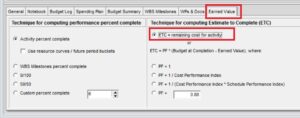
It is showing the techniques for computing Estimate to
Complete (ETC).
In the present case, those values are coming by default, i.e. by taking ETC=remaining cost of the activity.
From the formula, we have:
ETC= remaining cost of the activity
ETC= Budget at Completion (BAC) – Actual Cost (AC)
ETC= $323,848 – $47,544
ETC= $276,304
Performance Factor (PF) cases and formulas explained:
As the above value of ETC can’t provide a real forecast for the project, so we have to consider different cases for our
convenience to reach the closest value of ETC. This all is done through the different values of a factor called
Performance Factor (PF).
For all of these cases, the formula to calculate Estimate to
Complete (ETC) shall be as follows
ETC= PF x ( Budget at Completion – Earned Value )
What is meant by PF=1?
If the project is going well, under budget, and on schedule then this case is recommended.
It means, the remaining activities will be completed with the same cost as per our target, then the value of ETC shall
be calculated by taking PF=1. This value of the Performance Factor is also known as the Optimistic value.

Selecting ‘’PF=1’’ and clicking on ‘’Yes’’, will change all values as per the image shown below
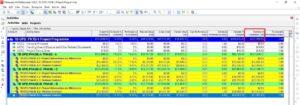
Here, the formula applied is as under.
PF= 1
ETC= 1 x ( $323,848 – $39,432)
ETC= $284,416
What is meant by PF=1/CPI?
To get the most likely result this case is recommended. It means the remaining activities will be completed as per the
current Cost Performance Index (CPI). Hence, this value of PF can generate the most probable value of ETC.
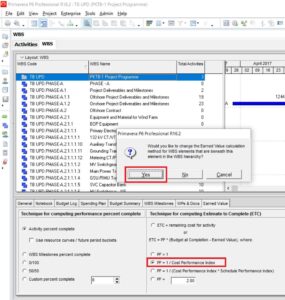
Selecting ‘’PF=1/ Cost Performance Index’’ and clicking on ‘’Yes’’, will change all values accordingly.
Here, the formula applied is as under.
PF= 1 / CPI
PF= 1 / 0.83
PF= 1.206
ETC= PF x ( BAC – EV )
ETC= 1.206 x ( $323,848 – $39,432)
ETC= $342,926
What is meant by PF=1/CPIxSPI?
To get a pessimistic result this case is recommended.
It means, the remaining activities will be completed as per the current Cost Performance Index (CPI) and current
Schedule Performance Index (SPI). Hence, this value of PF can generate the most pessimistic value of ETC if the project
is going behind schedule and above budget.
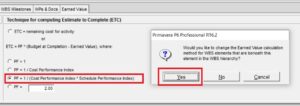
Selecting ‘’PF=1/ Cost Performance Index * Schedule Performance Index’’ and clicking on ‘’Yes’’, will change all values
accordingly.
Here, the formula applied is as under.
PF= 1 / CPI * SPI
PF= 1 / (0.83 x 0.88)
PF= 1.36
ETC= PF x ( BAC – EV )
ETC= 1.36 x ( $323,848 – $39,432)
ETC= $388,118
What is meant by PF= (custom value)?
This option is recommended to anticipate future value per our custom value.
It means the remaining activities will be completed as per the value entered. For example, if we enter PF=1.5, it means
the remaining activities will cost 150% of the budgeted price, and similarly, PF=2 means the remaining activities will
cost double than our budgeted price.
What is meant by PF= 0.8?
If we enter PF=0.8, it means the remaining activities will cost 20% less than the budgeted price.
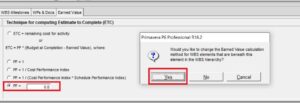
Selecting ‘’PF= 0.8’’ and clicking on ‘’Yes’’, will change all values as per the below image.
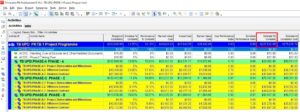
Here, the formula applied is as under.
PF= 0.8
ETC= PF x ( BAC – EV )
ETC= 0.8 x ( $323,848 – $39,432)
ETC= $227,532
What is meant by PF= 1.5?
If we enter PF=1.5, it means the remaining activities will cost 50% more than the budgeted price.

Selecting ‘’PF= 1.5’’ and clicking on ‘’Yes’’, will change all values as per the below image.
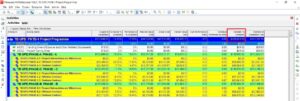
Here, the formula applied is as under.
PF= 1.5
ETC= PF x ( BAC – EV )
ETC= 1.5 x ( $323,848 – $39,432)
ETC= $426,624
Conclusion:
While calculating the value of Estimate to Complete (ETC) in Earned Value Management (EVM), the role of the Performance Factor is also important because every project/schedule will not behave CPI and SPI equal to one simultaneously. Performance Factor provides a better picture while calculating the cost of remaining activities, and it does so by considering the current values of CPI and SPI. These all calculations can be performed through MS Excel, but Oracle Primavera P6 is also well-versed in all of these options.





